The Best YA Books of 2022
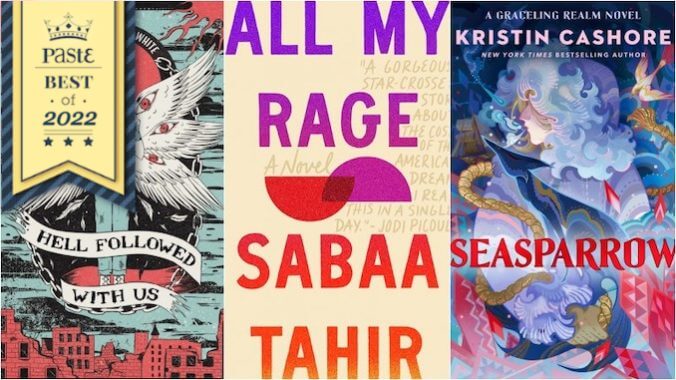
The young adult genre feels more expansive than ever before in 2022r, as popular authors delved into uncomfortable contemporary topics, explored realms of magical fantasy, remolded classic fairy and folk tales, and offered much-needed representation of all stripes in every sub-genre. What’s more, the complex themes and layered characters mean that despite being officially branded for the teen set, these are books that will absolutely appeal to readers of all ages who are just looking for some great and meaningful stories.
Here are our picks for the best YA books of 2022.
![]()
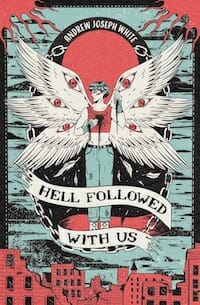 Hell Followed With Us by Andrew Joseph White
Hell Followed With Us by Andrew Joseph White
Even if you’ve read a lot of dystopian young adult fiction in recent years—I promise you, nothing has prepared you for Andrew Joseph White’s Hell Followed With Us. Pitch-black and rippling with righteous fury, this is a story about the end of the world and the monsters who bring it about. As a result, it contains everything from genocide and torture to murder and body horror. Full of explicit gore and violence, including shockingly detailed images of melting flesh, snapping bones, and various other mutilations and mutations, this is in no way a story for the faint of heart. And while there are wisps of occasional hope in White’s world, even the best of all possible outcomes are ones edged in (sometimes very literal) teeth and claws.
Yet, there is a complicated catharsis to be found in these pages, which are ultimately a story of both queer survival and queer perseverance, an unfortunately timely ode to those still fighting for the opportunity to be both seen and accepted for who they are. Hell Followed With Us is, truly, like nothing else you’ll read this year, and its deft balance of destruction and rebirth offers a satisfying, if far from saccharine, end. —-Lacy Baugher Milas
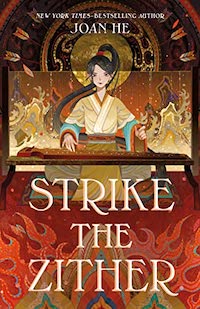 Strike the Zither by Joan He Joan He’s Strike the Zithe is her reinvention of the epic Romance of the Three Kingdoms, a historical fiction saga credited to Luo Guanzhong. While the stories are incredibly familiar to Chinese readers, they’re less well-known to American audiences. At 800,000 words and with a cast of thousands that would make Golden Age Hollywood proud, Romance of the Three Kingdoms is justifiably daunting to a modern reader. But its core story—three friends who swear an oath to support each other through thick and thin, a strategist so gifted as to make it seem as if the weather obeys their whims, honorable warriors determined not to win by cheating, and an abundance of courtly intrigue despite those honorable attitudes—resonates well beyond its early origins. Which is why it’s so delightful that He draws on those tales here and then makes them entirely her own.
Strike the Zither by Joan He Joan He’s Strike the Zithe is her reinvention of the epic Romance of the Three Kingdoms, a historical fiction saga credited to Luo Guanzhong. While the stories are incredibly familiar to Chinese readers, they’re less well-known to American audiences. At 800,000 words and with a cast of thousands that would make Golden Age Hollywood proud, Romance of the Three Kingdoms is justifiably daunting to a modern reader. But its core story—three friends who swear an oath to support each other through thick and thin, a strategist so gifted as to make it seem as if the weather obeys their whims, honorable warriors determined not to win by cheating, and an abundance of courtly intrigue despite those honorable attitudes—resonates well beyond its early origins. Which is why it’s so delightful that He draws on those tales here and then makes them entirely her own.
While readers who know Romance of the Three Kingdoms will be able to use their own knowledge of the source material to enrich their experience of He’s novel, familiarity isn’t necessary. Zephyr guides readers through all the trappings of the story seamlessly, emphasizing what parts are important to her own worldview while letting other details slide by. And He takes the world in a different direction almost immediately—that most of the main characters are women instead of men, in a story so traditionally masculine-dominated, sets a more modern-feeling tone. And He’s story notes at the end help readers identify where she’s made changes and why, especially where elements of the gods are concerned. —Alana Joli Abbot
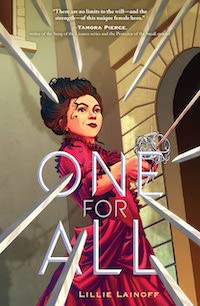 One for All by Lillie Lainoff Lillie Lainoff’s debut novel One for All is a gender-bent reimagining of The Three Musketeers that not only puts a feminist spin on a traditionally male-heavy classic but also places a chronically ill girl at its center, giving its heroine precisely the sort of whirlwind, swashbuckling adventure that so rarely features characters like her, even at their margins. One for All follows the story of Tania de Batz, the daughter of a Musketeer, an accomplished and talented swordswoman in her own right, and a girl who suffers from Postural Orthostatic Tachycardia Syndrome (POTS). A dysfunction of the autonomic nervous system that can cause abnormal symptoms in many parts of the body, the symptoms of POTS usually manifest as vertigo, lightheadedness, trouble thinking, blurred vision, or weakness.
One for All by Lillie Lainoff Lillie Lainoff’s debut novel One for All is a gender-bent reimagining of The Three Musketeers that not only puts a feminist spin on a traditionally male-heavy classic but also places a chronically ill girl at its center, giving its heroine precisely the sort of whirlwind, swashbuckling adventure that so rarely features characters like her, even at their margins. One for All follows the story of Tania de Batz, the daughter of a Musketeer, an accomplished and talented swordswoman in her own right, and a girl who suffers from Postural Orthostatic Tachycardia Syndrome (POTS). A dysfunction of the autonomic nervous system that can cause abnormal symptoms in many parts of the body, the symptoms of POTS usually manifest as vertigo, lightheadedness, trouble thinking, blurred vision, or weakness.
Life is hard enough for independent-minded young women in seventeenth-century France, let alone for a girl with Tania’s health struggles. Throughout the story, she is referred to as an “invalide,” “pauvre Tania,” and even called “broken” at one point by her own mother. A potential marriage match is thrown out when the family of her would-be suitor discovers Tania’s illness, and her best friend essentially disowns her over it, opting to publicly shame her at multiple points in the story. And though Tania eventually finds her tribe and a larger purpose in the most unexpected of places—the girls’ finishing academy that’s secretly a training ground for young female Musketeers—the fact of her illness never goes away. But it also doesn’t define who she is. —Lacy Baugher Milas
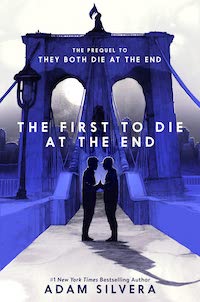 The First to Die at the End by Adam Silvera
The First to Die at the End by Adam Silvera
Those who read Adam Silvera’s heartwrenching They Both Die at the End won’t be surprised that its prequel, The First to Die at the End is equally emotionally affecting, even as it rehashes some of the same themes from its predecessor. The story, which is set on the very first day that Death-Cast begins making its life-ending calls, is both moving and fascinating in the ways that origin stories often are, and new leads Orion and Valentino are charming and compelling characters.
As the two young men—one of whom knows he doesn’t have long to live and the other who has no reason to suspect his life will be cut short—??wait to see which of them is fated to die before the end of the night, their story is intertwined with the nationwide chaos surrounding Death-Cast’s launch. Silvera deftly explores heavy topics like grief, abuse, religious faith, and the ethics of trying to predict one’s own mortality, and his propulsive storytelling makes the novel’s hefty page-count fly by. —-Lacy Baugher Milas
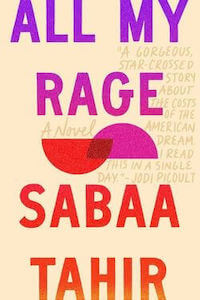 All My Rage by Sabaa Tahir Author Sabaa Tahir is best known for her sprawling Ember in the Ashes series, a four-book fantasy adventure inspired by ancient Rome about rebellion, resistance, and hope. But it is her contemporary debut, a searing, heartbreaking story called All My Rage that’s perhaps the best thing she’s written to date. Spread across two timelines in Lahore, Pakistan, and small-town Juniper, California, and told through dual perspectives, the book deftly explores the ways marginalized groups struggle under pervasive, structural racism in an America whose dreams of a brighter future are not always meant for all her residents.
All My Rage by Sabaa Tahir Author Sabaa Tahir is best known for her sprawling Ember in the Ashes series, a four-book fantasy adventure inspired by ancient Rome about rebellion, resistance, and hope. But it is her contemporary debut, a searing, heartbreaking story called All My Rage that’s perhaps the best thing she’s written to date. Spread across two timelines in Lahore, Pakistan, and small-town Juniper, California, and told through dual perspectives, the book deftly explores the ways marginalized groups struggle under pervasive, structural racism in an America whose dreams of a brighter future are not always meant for all her residents.
High school seniors Salahudin and Noor are eager to get out of their dead-end town but struggle with the intergenerational impact of substance abuse, debt, trauma, and poverty, all of which have hamstrung their efforts to change their lives. Their friendship, damaged by a confession of love one half of it has not figured out how to return, is the emotional crux around which this story hinges, a bond that is uplifting and heartbreaking by turns. As Noor hides secret dreams of attending university and Sal turns to illegal means in an attempt to pay off his family’s debt, both are forced to make difficult choices in a world where it often feels as though there’s no way out. —Lacy Baugher Milas
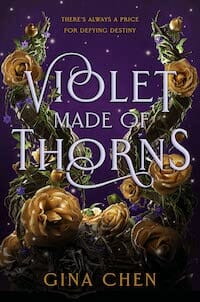 Violet Made of Thorns by Gina Chen A big part of the reason that Gina Chen’s Violet Made of Thorns feels like such a breath of fresh air in in the YA fantasy space is that even though it includes some extremely familiar tropes—a broody, rude potential love interest, a fairytale-like setting, and a kingdom under threat—its heroine is anything but traditional. Petty, unusually self-centered, selfish, and often straight-up unlikeable, Violet is not only tremendously entertaining as a charcter, the fact that she is allowed to essentially embrace all the traits YA heroines aren’t supposed to have ultimately reframes even the most overdone story beats in unexpected and surprising ways.
Violet Made of Thorns by Gina Chen A big part of the reason that Gina Chen’s Violet Made of Thorns feels like such a breath of fresh air in in the YA fantasy space is that even though it includes some extremely familiar tropes—a broody, rude potential love interest, a fairytale-like setting, and a kingdom under threat—its heroine is anything but traditional. Petty, unusually self-centered, selfish, and often straight-up unlikeable, Violet is not only tremendously entertaining as a charcter, the fact that she is allowed to essentially embrace all the traits YA heroines aren’t supposed to have ultimately reframes even the most overdone story beats in unexpected and surprising ways.
Whether that means knowingly lying about her supposedly prophetical magical visions on the order of the king or helping him manipulate his son to become the kind of man he wants him to be, she’s more than willing to do whatever it takes to make sure her own position is safe. Sharp-tongued, selfish, and an inveterate liar, Violet openly despises the politics and games of the courtly world she lives in even as she recognizes that the elevated position she so enjoys is only possible because of it. As you may have guessed already, Violet’s not here to make friends, and she’s not anyone’s hero. She’s not the sort of POV character that feels entirely trustworthy and Chen leans into this by repeatedly showing us that Violet’s willing to throw anyone or anything under the proverbial bus if she has to. Basically: We stan. — Lacy Baugher Milas
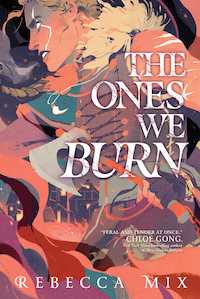 The Ones We Burn by Rebecca Mix Young adult fantasy often uses outlandish settings and magical characters to explore all too relatable and human questions of identity and belonging. Rebecca Mix’s The Ones We Burn is, on paper, a political fantasy about the uneasy tension between two kingdoms comprised of people who are very different from one another. (Though it ultimately evolves into something much more emotionally complex.) The magical denizens of Witchik and the largely mortal humans of Isodal once had a fruitful connection between their lands but have since grown distrustful and fearful of one another—despite the fact that the equally magical Skybreaker kings have sat on the throne of Isodal for years.
The Ones We Burn by Rebecca Mix Young adult fantasy often uses outlandish settings and magical characters to explore all too relatable and human questions of identity and belonging. Rebecca Mix’s The Ones We Burn is, on paper, a political fantasy about the uneasy tension between two kingdoms comprised of people who are very different from one another. (Though it ultimately evolves into something much more emotionally complex.) The magical denizens of Witchik and the largely mortal humans of Isodal once had a fruitful connection between their lands but have since grown distrustful and fearful of one another—despite the fact that the equally magical Skybreaker kings have sat on the throne of Isodal for years.
The novel follows the story of Ranka, a young blood witch who is chosen to serve as a political bride to keep the peace between the witch clans and the human world. But when she arrives in the capital city of Seaswept—armed with a plot to find a missing witch and assassinate the man she’s meant to marry—Ranka learns that nothing is what she expected. As she begins to question whether she has a chance at a future that doesn’t involve being an unstoppable killing machine for those who claim her loyalty, she’s also forced to confront her own past—which may have much darker elements than she’s been willing to really let herself remember.
As a character, Ranka’s arc has familiar elements from many other YA fantasies. A lost girl with a deadly magical gift she didn’t ask for and can’t entirely control, she has many sisters within this genre space. But Mix still manages to find something new to explore by honing in on the horrific trauma at the heart of her story in ways that many books like this one often choose to ignore. Because while Ranka may be a uniquely powerful chosen one with a rare gift, she’s also a young girl struggling to process an unimaginable amount of emotional damage, rooted in the abuse she’s suffered at the hands of those who were meant to love her best. — Lacy Baugher Milas
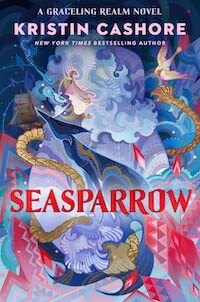 Seasparrow by Kristin Cashore “Things keep happening.” These three words might not seem like much, but when Queen Bitterblue’s secret half-sister and sometimes spy Hava reels them out to a new friend near the end of Seasparrow, the fifth installment in Kristin Cashore’s acclaimed Graceling Realm series, they might as well be the pulled pin of another zilfium bomb. Only, rather than it being a colony of silbercows or the secret lab of Winterkeep’s greatest atomic physicist being blown apart, this time it’s the psychic fortress Hava’s spent the better part of two deeply traumatic decades hiding behind. If that sounds like the grimmest of emotional Gordian knots for Cashore to have tied Seasparrow’s snowy survival adventure around, it’s possible you’ve forgotten the various abuses, traumas, and psychological devastation at the core of the rest of the series. Hard-won healing from a lifetime of soul-scarring injury? Par for the Graceling Realm course!
Seasparrow by Kristin Cashore “Things keep happening.” These three words might not seem like much, but when Queen Bitterblue’s secret half-sister and sometimes spy Hava reels them out to a new friend near the end of Seasparrow, the fifth installment in Kristin Cashore’s acclaimed Graceling Realm series, they might as well be the pulled pin of another zilfium bomb. Only, rather than it being a colony of silbercows or the secret lab of Winterkeep’s greatest atomic physicist being blown apart, this time it’s the psychic fortress Hava’s spent the better part of two deeply traumatic decades hiding behind. If that sounds like the grimmest of emotional Gordian knots for Cashore to have tied Seasparrow’s snowy survival adventure around, it’s possible you’ve forgotten the various abuses, traumas, and psychological devastation at the core of the rest of the series. Hard-won healing from a lifetime of soul-scarring injury? Par for the Graceling Realm course!
To readers just coming off the experience of Winterkeep, this shift is bound to be disorienting. In pretty much every respect, the two books couldn’t be more different. Where Winterkeep was a plotty whirlwind, all cunning political intrigue, and nail-biting kidnap thriller, Seasparrow is a long trudge down a bleak, narratively agnostic ice tunnel. Where Winterkeep flips acrobatically between multiple POV characters, whose stories unfurl effectively through limited omniscient third person, Seasparrow traps the reader deep inside Hava’s head, and her first-person narration manages to be so suffocating that not only are we excluded from any meaningful understanding of what’s going on with the rest of the shipwrecked party throughout their ordeal—nevermind the broader political implications Bitterblue was left to work through vis à vis everything discovered about zilfium in Winterkeep. That Cashore is able to make such an exhausting slog through a single character’s trauma not just eminently readable but deeply effective in its service of the series’ broader political and ideological arcs isn’t a surprise: that’s the kind of narrative highwire act she’s spent five books proving herself an expert at. Nevertheless, the deftness with which she makes ”Things keep happening” the most natural cathartic breakthrough of Hava’s slog feels not so much graceful as it does like an actual grace. —Alexis Gunderson
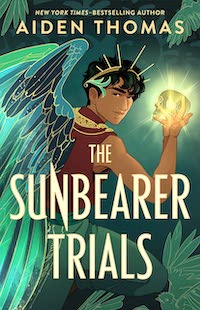 The Sunbearer Trials by Aiden Thomas It takes a strong person, and a strong protagonist, to speak up for what they believe, even when what they choose isn’t popular. But such protagonists don’t always see themselves as strong. In the case of Teo in The Sunbearer Trials, the newest YA fantasy from author Aiden Thomas, he only believes that he’s a troublemaker. And it takes him a long time in the story to realize that sometimes, a little trouble is needed. Sometimes, so-called “good trouble” (as the legendary Representative John Lewis termed it) is an absolutely necessary part of changing unjust systems. And Teo’s world needs a lot of change in order to be more just.
The Sunbearer Trials by Aiden Thomas It takes a strong person, and a strong protagonist, to speak up for what they believe, even when what they choose isn’t popular. But such protagonists don’t always see themselves as strong. In the case of Teo in The Sunbearer Trials, the newest YA fantasy from author Aiden Thomas, he only believes that he’s a troublemaker. And it takes him a long time in the story to realize that sometimes, a little trouble is needed. Sometimes, so-called “good trouble” (as the legendary Representative John Lewis termed it) is an absolutely necessary part of changing unjust systems. And Teo’s world needs a lot of change in order to be more just.
For The Sunbearer Trials (and its presumed sequel—be warned, the novel ends on a cliffhanger!), Thomas creates a secondary fantasy world that’s technologically similar to ours, but in which gods, demigods, and mortal humans openly walk together. Long ago, the sun god, Sol, sacrificed themself to save humans from the treacherous Obsidian gods, binding them into constellations to keep them from bringing chaos to the world. To keep Sol’s protections active, and to hold the Obsidians at bay, those known as semidioses, the children of the Gold and Jade gods, take part in the Sunbearer Trials. The winner, the Sunbearer, renews the sun stones in each temple with the blood of the loser, who is sacrificed in Sol’s image.
The rich world Thomas creates around the death-game theme is populated with a cast of well-developed, diverse characters. Even the most brutish, superior bullies among the Golds have moments that show a different, more sympathetic side. Teo’s former friend (and possible love interest) Aurelio, Niya, and Xio are frequently the most central figures, but the other teens among the ten never feel like they fade into the background as static. Each is a unique person with their own fears and feelings about the trials—something difficult to accomplish with such a large supporting cast in a single book. With a central mystery, a series of challenges worthy of the best magical tournaments in this genre, and a distinct Latinx inspiration, The Sunbearer Trials offers plenty in terms of action and plot, but centers itself in the justice-seeking heart of its protagonist. The story leaves Teo still questioning his choices, but readers will have faith that in the next novel, he’ll succeed in making his world a better, more equal place. — Alana Joli Abbott
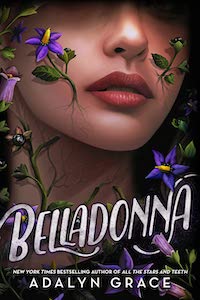 Belladonna by Adalyn Grace Adalyn Grace’s Belladonna is a hard novel to categorize. The book sits at an intriguing crossroads within the world of publishing—a YA novel that deals with very adult themes like murder and sex, a Gothic romance that is also very clearly a coming-of-age tale about a young woman finally claiming her own power, both literally and figuratively. It also occupies an intriguing liminal space in terms of the type of story it’s telling as well, mixing lush fantasy elements with a compelling murder mystery about a serial poisoner, as well as a swoony romance involving the literal personification of death. Yes, there are certainly moments where Belladonna can feel a bit overstuffed, as though the story is struggling to balance the many masters it must serve. But the book’s extremely unique blend of tropes ultimately mixes together to form an enjoyable, if somewhat unconventional, treat.
Belladonna by Adalyn Grace Adalyn Grace’s Belladonna is a hard novel to categorize. The book sits at an intriguing crossroads within the world of publishing—a YA novel that deals with very adult themes like murder and sex, a Gothic romance that is also very clearly a coming-of-age tale about a young woman finally claiming her own power, both literally and figuratively. It also occupies an intriguing liminal space in terms of the type of story it’s telling as well, mixing lush fantasy elements with a compelling murder mystery about a serial poisoner, as well as a swoony romance involving the literal personification of death. Yes, there are certainly moments where Belladonna can feel a bit overstuffed, as though the story is struggling to balance the many masters it must serve. But the book’s extremely unique blend of tropes ultimately mixes together to form an enjoyable, if somewhat unconventional, treat.
Grace’s debut All the Stars and Teeth duology (which is also great and you should read it!) was most notable for the array of complicated female characters present in its high seas adventure, from a princess determined to make herself worthy of the throne she’s set to inherit to a fierce mermaid out for revenge. Belladonna continues that trend, offering up a lead heroine in Signa Farrow who is equal parts reckless, brave, loyal, and foolhardy. Desperate to experience everything life has to offer after years of lack, Signa finds herself enjoying the things her handy ladies’ guidebook to beauty and etiquette says a well-bred young woman doesn’t indulge in, from food to flirtation. But as she slowly begins to realize that there’s nothing wrong with being an independent woman who thinks for herself, she finds her inner steel. A second murder closes the novel and opens the door to a sequel, and I’m pretty sure I won’t be the only one eagerly waiting to find out where Signa’s story goes next. —Lacy Baugher Milas
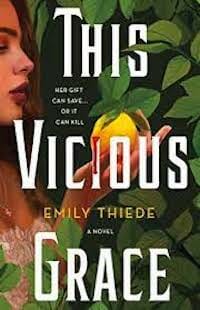 This Vicious Grace by Emily Thiede Author Emily Thiede’s debut novel This Vicious Grace ticks a lot of familiar boxes: A divinely blessed heroine has tremendous power but is essentially cursed to carry it alone (literally, she’ll kill anyone she touches). She must help save her homeland from a ritualistic invasion of demonic forces. She falls in love with a man who comes from the same subgroup she’s been taught all her life was not just an enemy but evil. And she’ll have to figure out who she really is along the way. Yet, Thiede’s story manages to mix all these elements together into a near-perfect blend of fantasy romance magic, one that will leave readers both thoroughly satisfied and eager for a sequel.
This Vicious Grace by Emily Thiede Author Emily Thiede’s debut novel This Vicious Grace ticks a lot of familiar boxes: A divinely blessed heroine has tremendous power but is essentially cursed to carry it alone (literally, she’ll kill anyone she touches). She must help save her homeland from a ritualistic invasion of demonic forces. She falls in love with a man who comes from the same subgroup she’s been taught all her life was not just an enemy but evil. And she’ll have to figure out who she really is along the way. Yet, Thiede’s story manages to mix all these elements together into a near-perfect blend of fantasy romance magic, one that will leave readers both thoroughly satisfied and eager for a sequel.
Set on the island of Saverio, This Vicious Grace follows the story of Alessa, chosen by the goddess Dea to stand against the demon hordes the evil god Crollo will send forth to try and destroy humanity. As a Finestra, her powerful ability to amplify magic is meant to be paired with a Fonte, a person blessed with offensive abilities such as the power to control the elements or manipulate matter. These divine saviors will stand against the monsters during a generational calamity known as the Divorando, and the fate of their island is in their hands.
And as fantasy heroines go, Alessa is a standout: Clever, capable, and deeply loyal to both those she cares about and the city that she calls home, she nevertheless questions her life and whether she’s worthy of the divine duty that’s been pressed upon her, wondering whether Savario might be better off without her. Her slow discovery and acceptance of her own worth—and that the things others might most frequently criticize about her are her greatest strength —is a delight to watch unfold. It’s not a surprise that Alessa eventually grows into the hero she was called to be, but the arc of her emotional journey is especially satisfying. — Lacy Baugher Milas







































